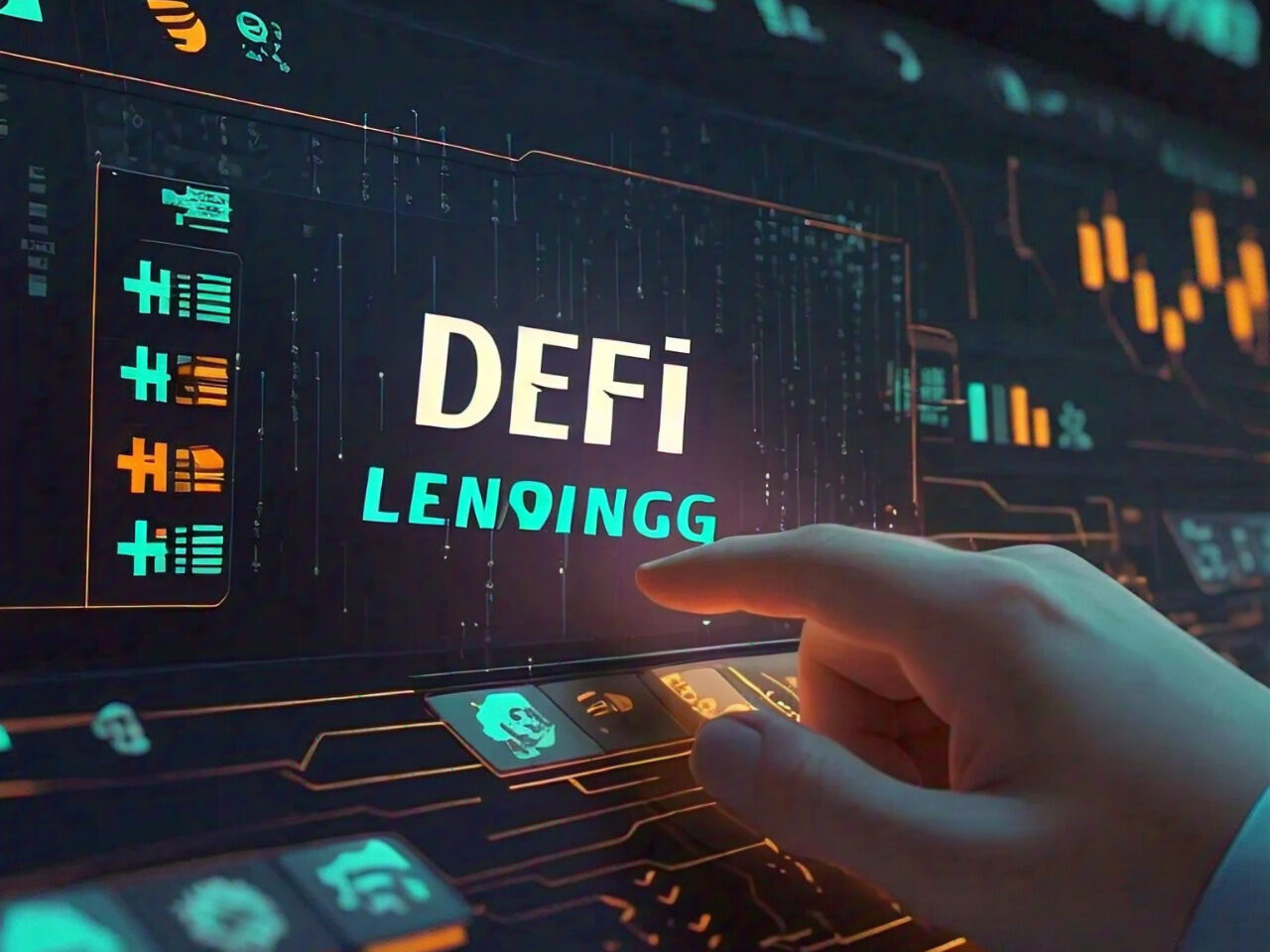
Decentralized Finance (DeFi) has revolutionized the financial landscape, offering unparalleled opportunities for individuals to lend, borrow, and earn interest on their digital assets. DeFi lending, in particular, has gained significant traction, attracting crypto enthusiasts and investors seeking passive income and diversification. However, navigating this complex and rapidly evolving space can be daunting.
In this comprehensive guide, we will walk you through the fundamentals of DeFi lending, its benefits and risks, and provide actionable insights to help you get started. Whether you’re a seasoned investor or a curious newcomer, this guide will empower you to make informed decisions and capitalize on the vast potential of DeFi lending.
What is DeFi Lending?
DeFi lending enables individuals to lend their digital assets to borrowers in exchange for interest payments, without relying on traditional financial intermediaries. This peer-to-peer lending model is facilitated by decentralized platforms, utilizing smart contracts to ensure secure, transparent, and efficient transactions.
Why DeFi Lending?
DeFi lending offers numerous benefits, including:
- Passive income: Earn interest on your digital assets
- Decentralization: No reliance on traditional financial institutions
- Accessibility: Lend and borrow with global accessibility
- Transparency: Smart contracts ensure transparent transactions
Target Audience
This guide is tailored for:
- Crypto enthusiasts seeking to expand their investment horizons
- Investors looking to diversify their portfolios
- Individuals interested in exploring DeFi lending opportunities
What to Expect
In this guide, we will cover:
- DeFi lending fundamentals and benefits
- Popular DeFi lending platforms and protocols
- Investment opportunities and risk management strategies
- Step-by-step guides to getting started with DeFi lending
DeFi Lending Fundamentals
What is DeFi Lending?
DeFi lending is a decentralized finance model that enables individuals to lend their digital assets to borrowers in exchange for interest payments. This peer-to-peer lending model is facilitated by decentralized platforms, utilizing smart contracts to ensure secure, transparent, and efficient transactions.
Key Components of DeFi Lending
- Lenders: Individuals or institutions lending digital assets.
- Borrowers: Individuals or institutions borrowing digital assets.
- DeFi Platforms: Decentralized platforms facilitating lending and borrowing.
- Smart Contracts: Self-executing contracts ensuring secure transactions.
Benefits of DeFi Lending
- Passive Income: Earn interest on digital assets.
- Decentralization: No reliance on traditional financial institutions.
- Accessibility: Global accessibility for lending and borrowing.
- Transparency: Smart contracts ensure transparent transactions.
Real-Life Examples
- Compound: A DeFi lending platform offering 2.5%-10% APY.
- Aave: A DeFi lending platform offering flash loans and credit delegation.
- MakerDAO: A DeFi lending platform issuing stablecoin DAI.
Risks Associated with DeFi Lending
- Smart Contract Risks: Vulnerabilities in smart contracts.
- Market Volatility: Fluctuations in digital asset values.
- Liquidity Risks: Difficulty withdrawing assets.
- Regulatory Risks: Evolving regulatory landscape.
Mitigating Risks
- Diversification: Spread investments across platforms.
- Risk Management: Monitor market trends and adjust strategies.
- Education: Understand DeFi lending fundamentals.
Popular DeFi Lending Platforms
Overview
DeFi lending platforms provide the infrastructure for lenders and borrowers to interact, offering various features and benefits. Here are some popular DeFi lending platforms:
1. Compound
- Interest Rates: 2.5% – 10% APY
- Supported Assets: ETH, BAT, REP, ZRX, and more
- Features: Decentralized, open-source, and audited smart contracts
- Example: Lend 10 ETH on Compound at 5% APY, earning 0.5 ETH interest per year
2. Aave
- Interest Rates: 2% – 15% APY
- Supported Assets: ETH, DAI, USDC, and more
- Features: Decentralized, flash loans, and credit delegation
- Example: Borrow 100 DAI on Aave at 5% APY, paying 5 DAI interest per year
3. MakerDAO
- Interest Rates: 2% – 8% APY
- Supported Assets: DAI (stablecoin), ETH, and BAT
- Features: Decentralized, stablecoin issuance, and governance
- Example: Mint 100 DAI on MakerDAO, paying 2% stability fee
4. dYdX
- Interest Rates: 2% – 10% APY
- Supported Assets: ETH, DAI, USDC, and more
- Features: Decentralized, margin trading, and lending
- Example: Lend 10 ETH on dYdX at 5% APY, earning 0.5 ETH interest per year
5. BlockFi
- Interest Rates: 4% – 8% APY
- Supported Assets: BTC, ETH, USDC, and more
- Features: Centralized, insured, and institutional-grade
- Example: Lend 1 BTC on BlockFi at 6% APY, earning 0.06 BTC interest per year
Comparison of DeFi Lending Platforms
| Platform | Interest Rates | Supported Assets | Features |
|---|---|---|---|
| Compound | 2.5%-10% | ETH, BAT, REP | Decentralized, open-source |
| Aave | 2%-15% | ETH, DAI, USDC | Flash loans, credit delegation |
| MakerDAO | 2%-8% | DAI, ETH, BAT | Stablecoin issuance, governance |
| dYdX | 2%-10% | ETH, DAI, USDC | Margin trading, lending |
| BlockFi | 4%-8% | BTC, ETH, USDC | Centralized, insured |
Key Considerations
When choosing a DeFi lending platform, consider:
- Interest rates and fees
- Supported assets and liquidity
- Security measures and audits
- User interface and experience
- Reputation and community
Investment Opportunities in DeFi Lending

DeFi lending offers various investment opportunities for crypto enthusiasts and investors. Here are some ways to invest:
1. Lending on DeFi Platforms
- Yield: 2% – 15% APY
- Risk: Low to moderate
- Example: Lend 10 ETH on Aave at 5% APY, earning 0.5 ETH interest per year
2. Yield Farming
- Yield: 10% – 50% APY
- Risk: Moderate to high
- Example: Provide liquidity to Uniswap’s ETH-DAI pool, earning 20% APY in UNI tokens
3. Liquidity Provision
- Yield: 5% – 20% APY
- Risk: Low to moderate
- Example: Provide liquidity to Curve’s DAI-USDC pool, earning 10% APY in CRV tokens
4. Stablecoin Lending
- Yield: 2% – 8% APY
- Risk: Low
- Example: Lend 1000 DAI on Compound at 4% APY, earning 40 DAI interest per year
5. Tokenized Lending
- Yield: 5% – 20% APY
- Risk: Moderate
- Example: Invest in tokenized lending protocols like Tokenlon or Dharma
Real-Life Examples:
- Compound’s COMP token: Earned 50% APY through yield farming in 2020
- Aave’s LEND token: Rose 300% in value after listing on Binance in 2020
- MakerDAO’s DAI: Maintained stability during market volatility, attracting lenders
Key Considerations:
When investing in DeFi lending:
- Risk management: Diversify investments and adjust risk tolerance
- Liquidity: Ensure easy asset withdrawal and conversion
- Regulatory compliance: Understand local regulations and tax implications
Investment Strategies:
- Diversification: Spread investments across platforms and assets
- Yield optimization: Maximize returns through yield farming and liquidity provision
- Risk hedging: Use stablecoins or other assets to mitigate risk
Evaluating DeFi Lending Platforms’ Credibility
Evaluating the credibility of DeFi lending platforms is crucial to ensure safe and profitable investments. Here are key factors to consider:
1. Security Measures
- Smart Contract Audits: Look for platforms with audited smart contracts.
- Bug Bounty Programs: Platforms with bug bounty programs encourage security researchers to identify vulnerabilities.
- Penetration Testing: Regular penetration testing ensures platform security.
2. Transparency
- Open-Source Code: Platforms with open-source code allow for community scrutiny.
- Clear Fee Structures: Understand platform fees and charges.
- Regular Updates: Platforms with regular updates demonstrate commitment to improvement.
3. Reputation
- Community Feedback: Research community feedback on social media and forums.
- Partnerships and Collaborations: Platforms with reputable partnerships demonstrate credibility.
- Regulatory Compliance: Ensure platforms comply with local regulations.
4. Liquidity
- Trading Volume: Platforms with high trading volume ensure liquidity.
- Asset Diversity: Platforms with diverse asset offerings reduce risk.
- Withdrawal Processes: Ensure easy and efficient withdrawal processes.
Real-Life Examples:
- Compound’s Security Audit: Compound’s smart contract audit by Trail of Bits ensured security.
- Aave’s Transparency: Aave’s open-source code and clear fee structure demonstrate transparency.
- MakerDAO’s Reputation: MakerDAO’s partnerships with reputable organizations demonstrate credibility.
Red Flags:
- Unaudited Smart Contracts: Platforms with unaudited smart contracts pose security risks.
- Hidden Fees: Platforms with hidden fees can lead to unexpected losses.
- Poor Community Feedback: Platforms with negative community feedback may indicate credibility issues.
Evaluation Checklist:
- Security measures
- Transparency
- Reputation
- Liquidity
- Regulatory compliance
By evaluating DeFi lending platforms’ credibility, investors can make informed decisions and minimize risk.
Calculating Investment Returns
Calculating investment returns is crucial to evaluate the profitability of DeFi lending investments. Here’s how to calculate returns:
1. Annual Percentage Yield (APY)
- Formula: APY = (Interest Rate x Principal) / Principal
- Example: Lend 100 ETH at 5% APY, earning 5 ETH interest per year
2. Return on Investment (ROI)
- Formula: ROI = (Gain – Cost) / Cost
- Example: Invest 100 ETH in a DeFi lending platform, earning 10 ETH interest, ROI = 10%
3. Compound Interest
- Formula: A = P x (1 + r/n)^(n*t)
- Example: Lend 100 ETH at 5% APY, compounded monthly, A = 105.12 ETH after 1 year
Real-Life Examples:
- Compound’s Interest Calculator: Compound’s calculator helps users estimate returns.
- Aave’s APY Calculator: Aave’s calculator provides APY estimates based on interest rates.
- MakerDAO’s DAI Savings Rate: MakerDAO’s DAI savings rate offers 2% APY.
Factors Affecting Returns:
- Interest Rates: Fluctuations in interest rates impact returns.
- Market Volatility: Market fluctuations affect asset values.
- Liquidity: Illiquidity can reduce returns.
- Fees: Platform fees and charges reduce returns.
Maximizing Returns:
- Diversification: Spread investments across platforms and assets.
- Yield Optimization: Maximize returns through yield farming and liquidity provision.
- Risk Management: Hedge against market volatility.
Return Calculation Tools:
- DeFi Rate: DeFi Rate provides APY and ROI calculations for DeFi lending platforms.
- Crypto APY: Crypto APY offers APY calculations for various DeFi platforms.
- BlockFi’s Interest Calculator: BlockFi’s calculator estimates interest earnings.
By understanding how to calculate investment returns, DeFi lending investors can make informed decisions and optimize their returns.
Managing Investment Risks

Managing investment risks is crucial to ensure profitable DeFi lending investments. Here are strategies to mitigate risks:
1. Diversification
- Asset Diversification: Spread investments across various assets (e.g., ETH, BTC, DAI).
- Platform Diversification: Invest in multiple DeFi lending platforms (e.g., Compound, Aave, MakerDAO).
- Strategy Diversification: Combine lending, yield farming, and liquidity provision.
2. Risk Assessment
- Platform Risk: Evaluate platform security, liquidity, and reputation.
- Market Risk: Monitor market trends, volatility, and asset correlations.
- Regulatory Risk: Stay informed about regulatory changes.
3. Hedging
- Stablecoin Lending: Lend stablecoins (e.g., DAI, USDC) to reduce volatility risk.
- Collateralized Lending: Use collateralized loans to reduce default risk.
- Options and Futures: Utilize derivatives to hedge against market fluctuations.
4. Stop-Loss Strategies
- Price-Based Stop-Loss: Set price thresholds to automatically sell assets.
- Time-Based Stop-Loss: Set time limits to automatically withdraw investments.
Real-Life Examples:
- Compound’s Risk Management: Compound’s diversification and hedging strategies mitigate risks.
- Aave’s Collateralized Lending: Aave’s collateralized loans reduce default risk.
- MakerDAO’s Stability Fee: MakerDAO’s stability fee adjusts to maintain DAI stability.
Risk Management Tools:
- DeFi Pulse: DeFi Pulse provides risk assessments and rankings for DeFi platforms.
- CryptoSpectator: CryptoSpectator offers risk management tools and analytics.
- BlockFi’s Risk Management: BlockFi’s risk management solutions provide hedging and diversification strategies.
Best Practices:
- Regularly Monitor Investments: Stay informed about market trends and platform changes.
- Adjust Risk Tolerance: Reassess risk tolerance as market conditions change.
- Educate Yourself: Continuously learn about DeFi lending and risk management.
By implementing effective risk management strategies, DeFi lending investors can minimize losses and maximize returns.
Tax Implications and Regulatory Considerations
Understanding tax implications and regulatory considerations is crucial for DeFi lending investors.
Tax Implications:
- Capital Gains Tax: Taxed on profits from selling or trading digital assets.
- Interest Income Tax: Taxed on interest earned from lending.
- Tax Reporting: Accurately report DeFi lending income to tax authorities.
Regulatory Considerations:
- Anti-Money Laundering (AML): DeFi platforms must comply with AML regulations.
- Know-Your-Customer (KYC): DeFi platforms must verify user identities.
- Securities and Exchange Commission (SEC): DeFi platforms must comply with SEC regulations.
Real-Life Examples:
- Compound’s Tax Guidance: Compound provides tax guidance for users.
- Aave’s Regulatory Compliance: Aave complies with AML and KYC regulations.
- MakerDAO’s SEC Compliance: MakerDAO complies with SEC regulations.
Tax and Regulatory Tools:
- CryptoTaxCalculator: CryptoTaxCalculator helps calculate tax liabilities.
- CoinTracker: CoinTracker provides tax reporting and tracking.
- DeFi Regulatory Tracker: DeFi Regulatory Tracker monitors regulatory updates.
Best Practices:
- Consult a Tax Professional: Ensure accurate tax reporting.
- Stay Informed: Monitor regulatory updates and changes.
- Comply with Regulations: Ensure DeFi lending activities comply with regulations.
Regulatory Bodies:
- Securities and Exchange Commission (SEC)
- Commodity Futures Trading Commission (CFTC)
- Financial Industry Regulatory Authority (FINRA)
By understanding tax implications and regulatory considerations, DeFi lending investors can ensure compliance and minimize potential risks.
Best Practices for DeFi Lending
To ensure successful DeFi lending, follow these best practices:
1. Diversification
- Asset Diversification: Spread investments across various assets (e.g., ETH, BTC, DAI).
- Platform Diversification: Invest in multiple DeFi lending platforms (e.g., Compound, Aave, MakerDAO).
- Strategy Diversification: Combine lending, yield farming, and liquidity provision.
2. Risk Management
- Risk Assessment: Evaluate platform security, liquidity, and reputation.
- Hedging: Use stablecoins or derivatives to mitigate market volatility.
- Stop-Loss Strategies: Set price or time thresholds to automatically sell assets.
3. Research and Due Diligence
- Platform Research: Investigate platform security, fees, and reputation.
- Asset Research: Understand asset market trends and volatility.
- Community Feedback: Monitor community feedback and reviews.
4. Security Measures
- Wallet Security: Use secure wallets (e.g., Ledger, Trezor) and enable 2FA.
- Private Key Management: Safeguard private keys and use password managers.
- Regular Updates: Stay updated with platform and wallet updates.
5. Tax and Regulatory Compliance
- Tax Reporting: Accurately report DeFi lending income to tax authorities.
- Regulatory Compliance: Ensure DeFi lending activities comply with regulations.
Real-Life Examples:
- Compound’s Diversification Strategy: Compound’s diversified lending portfolio minimizes risk.
- Aave’s Risk Management: Aave’s hedging strategies mitigate market volatility.
- MakerDAO’s Security Measures: MakerDAO’s secure wallet and private key management protect user assets.
Tools and Resources:
- DeFi Pulse: DeFi Pulse provides risk assessments and rankings for DeFi platforms.
- CryptoSpectator: CryptoSpectator offers risk management tools and analytics.
- BlockFi’s Risk Management: BlockFi’s risk management solutions provide hedging and diversification strategies.
Community Resources:
- Reddit’s r/DeFi: r/DeFi community discusses DeFi lending strategies and best practices.
- DeFi Subreddit: DeFi Subreddit shares knowledge and resources on DeFi lending.
- DeFi Discord: DeFi Discord community provides real-time discussions and support.
By following these best practices, DeFi lending investors can maximize returns, minimize risks, and ensure a successful investing experience.
Staying Updated on DeFi Trends

Staying informed about DeFi trends is crucial for making informed investment decisions.
1. DeFi News Sources
- Coindesk: Coindesk provides up-to-date DeFi news and analysis.
- The Defiant: The Defiant offers DeFi news, tutorials, and insights.
- DeFi Pulse: DeFi Pulse provides DeFi news, rankings, and analytics.
2. Social Media and Forums
- Twitter: Follow DeFi influencers, platforms, and projects (e.g., @CompoundFinance, @AaveAave).
- Reddit: Participate in r/DeFi, r/Ethereum, and project-specific subreddits.
- Discord: Join DeFi project Discords (e.g., Compound, Aave, MakerDAO).
3. DeFi Analytics Platforms
- DeFi Llama: DeFi Llama provides DeFi metrics, analytics, and rankings.
- DappRadar: DappRadar offers DeFi analytics, rankings, and insights.
- CryptoSpectator: CryptoSpectator provides DeFi analytics, news, and tutorials.
4. Research Reports and Whitepapers
- DeFi Research: DeFi Research publishes in-depth DeFi reports and analysis.
- Chainalysis: Chainalysis provides DeFi research reports and insights.
- Messari: Messari publishes DeFi research reports and analysis.
Real-Life Examples:
- Compound’s Governance Proposal: Compound’s governance proposal was discussed on Reddit and Twitter.
- Aave’s V2 Launch: Aave’s V2 launch was covered by Coindesk and The Defiant.
- MakerDAO’s DAI Stability Module: MakerDAO’s DAI stability module was analyzed by DeFi Research.
Influencers and Thought Leaders:
- Vitalik Buterin: Ethereum co-founder and DeFi thought leader.
- Robert Leshner: Compound founder and DeFi advocate.
- Stani Kulechov: Aave founder and DeFi expert.
Conferences and Events:
- DeFi Summit: Annual DeFi conference featuring industry leaders.
- Blockchain Week: Global blockchain conference covering DeFi topics.
- EthCC: Ethereum Community Conference discussing DeFi developments.
By staying updated on DeFi trends, investors can:
- Identify emerging opportunities
- Mitigate potential risks
- Make informed investment decisions
Getting Started with Defi Lending
Getting started with DeFi lending requires a basic understanding of blockchain technology, cryptocurrencies, and DeFi platforms.
Step 1: Set Up a Digital Wallet
- Hardware Wallets: Ledger, Trezor, or KeepKey for secure storage.
- Software Wallets: MetaMask, Trust Wallet, or Coinbase Wallet for convenience.
Step 2: Choose a DeFi Platform
- Compound: Lend ETH, BAT, REP, and more.
- Aave: Lend ETH, DAI, USDC, and more.
- MakerDAO: Mint DAI stablecoin.
Step 3: Fund Your Wallet
- Buy Cryptocurrencies: Use exchanges like Coinbase, Binance, or Kraken.
- Transfer Funds: Send cryptocurrencies to your digital wallet.
Step 4: Connect to DeFi Platform
- Web3 Browser: Use MetaMask or Brave to interact with DeFi platforms.
- Platform Interface: Connect your wallet to the DeFi platform.
Step 5: Lend Assets
- Select Asset: Choose the asset to lend (e.g., ETH, DAI).
- Set Interest Rate: Determine the interest rate for lending.
- Confirm Transaction: Approve the lending transaction.
Real-Life Examples:
- Lending 10 ETH on Compound: Earn 5% APY and 0.5 ETH interest per year.
- Borrowing 100 DAI on Aave: Pay 5% APY and 5 DAI interest per year.
- Minting 100 DAI on MakerDAO: Pay 2% stability fee.
Tips for Beginners:
- Start Small: Begin with small amounts to understand DeFi lending.
- Research Platforms: Investigate platform security, fees, and reputation.
- Monitor Markets: Keep track of market trends and adjust strategies.
Resources for Beginners:
- DeFi 101: DeFi educational resources for beginners.
- CryptoSpectator Academy: CryptoSpectator’s educational platform.
- DeFi Subreddit: r/DeFi community discussions and resources.
Common Mistakes to Avoid:
- Insufficient Research: Failing to research platforms and assets.
- Poor Risk Management: Neglecting risk management strategies.
- Inadequate Security: Failing to secure digital wallets.
By following these steps and tips, beginners can successfully start DeFi lending and navigate the DeFi ecosystem.
Conclusion
DeFi lending has revolutionized the financial landscape, offering unprecedented opportunities for investors to earn yields on their digital assets.
Key Takeaways:
- DeFi Lending Benefits: Earn passive income, diversify portfolios, and access global markets.
- DeFi Lending Risks: Market volatility, platform security, and regulatory uncertainty.
- DeFi Lending Strategies: Diversification, risk management, and hedging.
Future Outlook:
- Increased Adoption: Growing demand for DeFi lending and borrowing.
- Regulatory Clarity: Emerging regulatory frameworks for DeFi.
- Innovation: Advancements in DeFi technology and infrastructure.
Best Practices:
- Education: Continuously learn about DeFi lending and risk management.
- Diversification: Spread investments across platforms and assets.
- Risk Management: Implement hedging and stop-loss strategies.
Final Thoughts:
DeFi lending has transformed the financial landscape, offering unparalleled opportunities for investors. By understanding the benefits, risks, and strategies outlined in this guide, investors can navigate the DeFi ecosystem with confidence.
Additional Resources:
- (link unavailable) DeFi educational resources and community.
- The Defiant: DeFi news, tutorials, and insights.
- DeFi Pulse: DeFi rankings, analytics, and news.
Disclaimer:
This guide is for informational purposes only and should not be considered investment advice.
By embracing DeFi lending and its potential, investors can unlock new opportunities for growth and financial freedom.
Thank you for reading this comprehensive guide to DeFi lending.





